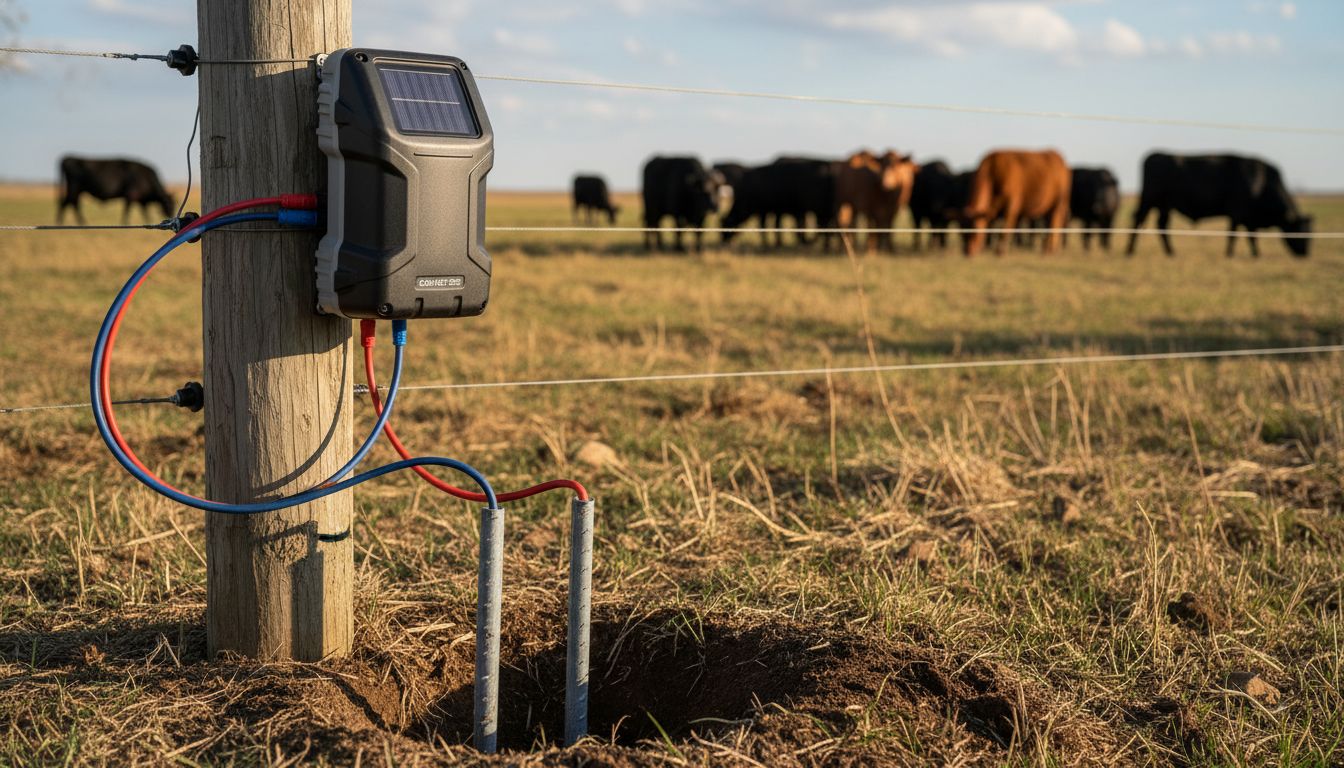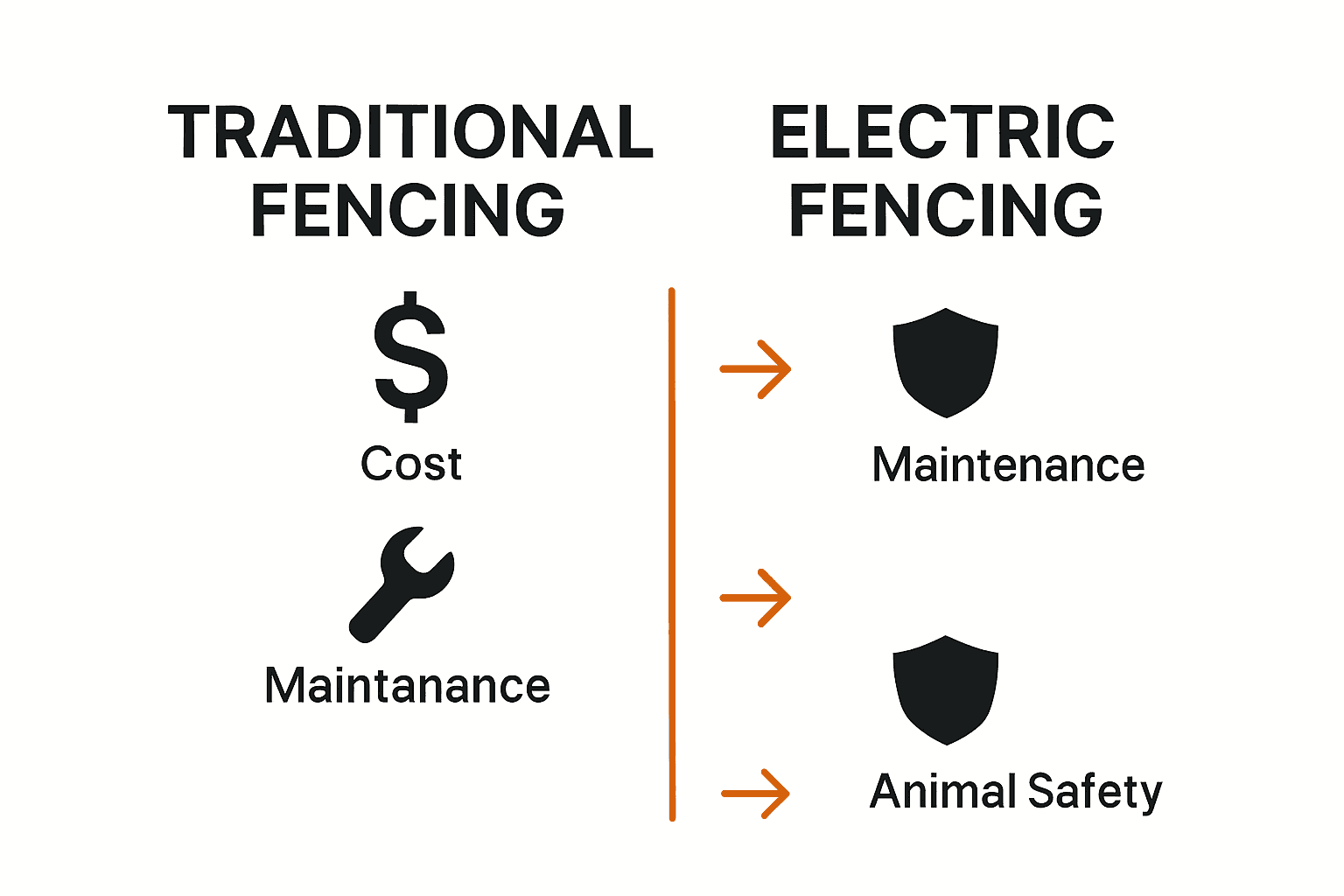Electric fencing now protects more than 40 million head of cattle worldwide, proving its impact on modern livestock management. Farmers and ranchers need solutions that balance containment, flexibility, and animal welfare. Electric fences not only keep herds safely where they belong but also do so with less effort and infrastructure compared to traditional methods. Discover how this innovative approach to cattle fencing offers both peace of mind and practical benefits to anyone responsible for livestock.
Table of Contents
- Defining Electric Fencing For Cattle
- Types Of Electric Fence Systems For Livestock
- Essential Features For Effective Cattle Fencing
- Installation And Maintenance Best Practices
- Comparing Costs, Risks, And Alternatives
Key Takeaways
| Point | Details |
|---|---|
| Effective Containment | Electric fencing provides a humane, psychological barrier for cattle management, enabling safe boundaries without causing long-term harm. |
| System Versatility | Various types of electric fencing systems, including permanent, semi-permanent, and temporary options, cater to diverse agricultural needs. |
| Key Installation Factors | Successful electric fence installation requires careful site evaluation, appropriate component selection, and regular maintenance to ensure optimal performance. |
| Cost Advantages | Electric fencing typically incurs lower initial installation costs and minimal maintenance requirements compared to traditional fencing methods. |
Defining Electric Fencing for Cattle
Electric fencing represents a sophisticated and effective livestock management solution designed to create secure boundaries for cattle herds. According to ahdb.org.uk, electric fencing operates as a psychological barrier that uses a pulse of electric current to condition animals against crossing boundary lines.
At its core, an electric fence works through a simple yet ingenious mechanism. Electric fence systems send controlled electrical pulses along fence lines from a central energizer. When cattle accidentally contact the fence, they complete an electrical circuit and receive a brief, startling shock. This momentary discomfort teaches livestock to respect fence boundaries without causing lasting physical harm. As pubs.ext.vt.edu explains, the shock serves as a psychological deterrent that effectively trains animals to avoid future contact.
Key characteristics of electric fencing for cattle include:
- Provides a humane boundary control method
- Creates a lightweight and flexible containment system
- Requires minimal physical infrastructure compared to traditional fencing
- Offers adaptable installation options across various terrains
- Delivers consistent deterrence without permanent physical restrictions
Understanding electric fencing involves recognizing its dual purpose: physical containment and behavioral conditioning. Unlike traditional solid barriers, electric fences leverage an animal’s natural avoidance response, making them an intelligent and efficient livestock management tool. Want to explore more about implementing electric fencing? Check out our guide on understanding electric fence basics.
Types of Electric Fence Systems for Livestock
Electric fencing for livestock presents a versatile range of system configurations designed to meet diverse agricultural needs. According to ahdb.org.uk, there are fundamentally three primary types of electric fencing systems: permanent, off-conventional, and temporary electric fencing.
Permanent Electric Fencing represents the most robust and long-term solution for livestock containment. These systems are engineered for durability, typically utilizing sturdy posts, multiple wire strands, and high-powered energizers to create consistent, reliable boundaries. Farmers often install permanent electric fences around primary pastures, large grazing areas, and property perimeters where consistent animal control is paramount.
The alternative configurations include:
- Semi-Permanent Systems: Offer moderate durability with increased flexibility
- Temporary Electric Fences: Lightweight and easily relocatable
- Off-Conventional Fences: Integrate electric components into traditional fence structures
As pubs.ext.vt.edu explains, these varied electric fencing systems provide ranchers with adaptable solutions for different livestock management scenarios. Whether you need rotational grazing setups or temporary enclosures, there’s an electric fencing system tailored to your specific requirements.
Want to explore more portable options? Check out our guide on portable electric livestock fencing.
Essential Features for Effective Cattle Fencing
Creating a robust electric fence for cattle requires careful consideration of multiple critical components. According to ahdb.org.uk, an effective electric fence system demands several key elements: an energizer, reliable power source, proper grounding system, and high-quality conductive materials.
Energizer Performance stands as the heart of any successful electric fencing setup. This critical device generates the electrical pulses that create the psychological barrier for cattle.
 Modern energizers come in various power ratings, designed to handle different pasture sizes and livestock requirements. The right energizer ensures consistent, safe electrical current that deters cattle without causing unnecessary harm.
Modern energizers come in various power ratings, designed to handle different pasture sizes and livestock requirements. The right energizer ensures consistent, safe electrical current that deters cattle without causing unnecessary harm.
Key essential features for cattle fencing include:
- Voltage Consistency: Maintains steady electrical current
- Robust Grounding System: Ensures complete electrical circuit
- Appropriate Wire Height: Targets cattle’s sensitive areas
- Durable Conductor Materials: Withstands environmental challenges
- Weather-Resistant Components: Performs in various climatic conditions
As pubs.ext.vt.edu explains, proper installation involves strategic wire placement and height to maximize the fence’s psychological impact. Curious about selecting the perfect fence for your herd? Check out our guide on essential tips for choosing the best cow fence.
Installation and Maintenance Best Practices
Installing an effective electric fence for cattle requires meticulous planning and strategic execution. According to ahdb.org.uk, successful installation involves selecting the appropriate fence type for specific livestock and terrain, ensuring precise component assembly, and implementing a comprehensive animal training strategy.
Fence Installation Fundamentals begin with careful site preparation and strategic component selection. Farmers must consider terrain characteristics, livestock behavior, and potential environmental challenges when designing their electric fencing system. This includes selecting robust posts, high-quality conductors, and positioning wires at optimal heights to create an effective psychological barrier for cattle.
Critical installation and maintenance steps include:
- Site Survey: Evaluate terrain and potential obstacles
- Precise Grounding: Establish a complete electrical circuit
- Component Selection: Choose weather-resistant materials
- Regular Voltage Testing: Maintain consistent electrical performance
- Periodic Visual Inspections: Check for damage or wear
As pubs.ext.vt.edu explains, training livestock to recognize and respect the fence is equally crucial for long-term effectiveness. Want to dive deeper into electric fence construction techniques? Check out our tutorial on building and testing electric fences for livestock safety.
Comparing Costs, Risks, and Alternatives
Evaluating electric fencing for cattle requires a comprehensive analysis of financial investment, operational risks, and potential alternatives. According to ahdb.org.uk, a typical three-line electric fence for cattle represents a cost-effective solution, with installation expenses ranging between 40p and 60p per meter.
Cost Considerations extend beyond initial installation expenses. While electric fencing offers an economical approach to livestock containment, farmers must factor in ongoing maintenance, potential equipment replacement, and the long-term performance characteristics. Operational risks are inherent in any fencing system, but electric fences provide unique advantages in managing livestock movement and preventing potential breaches.
Key comparative factors include:

- Initial Installation Costs: Lower compared to traditional fencing
- Maintenance Requirements: Minimal ongoing investment
- Livestock Safety: Psychological deterrent with reduced physical injury risk
- Flexibility: Easily modified and repositioned
- Durability: Resistant to environmental challenges
As pubs.ext.vt.edu explains, alternative fencing methods like traditional barbed wire or wooden fences often involve higher initial costs and more complex maintenance protocols. Interested in exploring different livestock fencing options? Check out our guide on 7 essential types of livestock fencing.
Secure Your Herd with the Right Electric Fence Today
Managing cattle with electric fencing means balancing effective containment with animal safety and ease of maintenance. If you have struggled with choosing the best energizer, proper wire height, or worry about the cost and durability of your fence, you are not alone. This guide highlights how electric fences create a psychological barrier that protects your livestock without harsh physical restrictions. Now it is time to put this knowledge into action and equip your farm with trusted products designed specifically for cattle fencing needs.

Discover a wide selection of electric fencing systems, components, and accessories at FenceFast.ca. From energizers and solar panels to connectors and weather-resistant wires, we provide durable solutions that match the essential features outlined in the guide. Start building a reliable fence that fosters long-term animal training and easy maintenance. Visit our electric fence basics guide to get expert tips, then shop with confidence knowing you have nationwide shipping and professional support. Protect your investment and your herd by choosing FenceFast today.
Frequently Asked Questions
What is electric fencing for cattle and how does it work?
Electric fencing for cattle is a livestock management system that uses electric pulses to create a psychological barrier. When cattle touch the fence, they receive a brief shock that conditions them to avoid crossing the boundary.
What are the main types of electric fencing systems for cattle?
The primary types of electric fencing systems for cattle include permanent, semi-permanent, and temporary electric fences. Each type varies in durability and flexibility, catering to different livestock management needs.
What essential features should I look for in an electric fence for cattle?
Key features of an effective electric fence for cattle include a reliable energizer, consistent voltage, a robust grounding system, appropriate wire height for livestock, durable conductor materials, and weather-resistant components to withstand environmental challenges.
How do I maintain an electric fence for optimal performance?
To maintain an electric fence, regularly test the voltage, conduct visual inspections for damage, ensure proper grounding, and select high-quality, weather-resistant materials. Periodic checks help address any wear and keep the fence effective in managing cattle.
